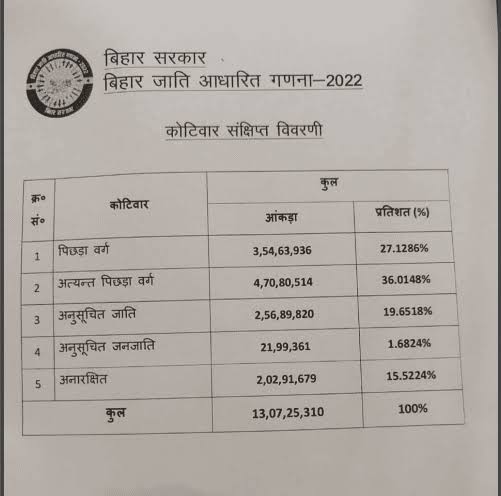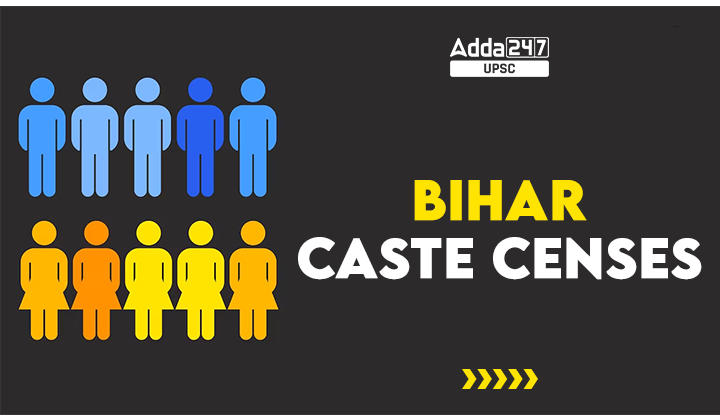Table of Contents
The release of caste census data by the Bihar government has sparked discussion and debate on the complex history of caste surveys in India. From 1951 to 2011, every census recorded data on Scheduled Castes and Scheduled Tribes but omitted information on other castes. This departure from the past, where caste data was collected until 1931, highlights the complex evolution of caste-based surveys in independent India.
Bihar Caste Census 2023
According to a recent Bihar Caste Census survey by the Government of Bihar, more than 63% of the population of Bihar belongs to the Other Backward Classes (OBC) and Extremely Backward Classes (EBC). Chief Minister Nitish Kumar praised the survey team while emphasizing unanimously approving the caste-based survey in the Bihar Assembly.
This article highlights the historical context of the caste census, the implications of the recent Bihar survey, and the broader importance of collecting data on caste and economic status to inform policy and development initiatives.
Bihar Caste Census Key Findings and Implications
OBC and EBC Demographic Majority
OBCs and EBCs constitute more than 63% of Bihar’s population, an important demographic revelation. This underlines the social and political importance of these groups, highlighting their numerical strength and potential impact on electoral dynamics.
Chief Minister’s Appreciation
Chief Minister Nitish Kumar’s appreciation of the survey team shows the political consensus on caste-based surveys in the Bihar Assembly. The acknowledgment of the importance of the survey marks a step towards accepting the socio-economic realities shaped by caste dynamics.
Bihar Caste Census Population
Bihar, the largest and most densely populated state in India, is characterized by its diverse social fabric. The Bihar Caste Census Population report reveals a significant diversity among its population in terms of caste categories. Among the population of over 13 crores, the report highlights that 27.1 percent belong to the Backward Classes, while an even higher percentage, 36 percent, falls under the Extremely Backward Class category (EBC). Scheduled Castes make up 19.7 percent of the population, and Scheduled Tribes constitute 1.7 percent. It’s worth noting that a portion, 15.5 percent, of the population is categorized as Unreserved.
This demographic distribution underscores the importance of understanding and addressing the unique social and economic challenges faced by each caste category within Bihar. Policymakers and social organizations must consider this diversity while formulating policies and programs to ensure inclusive development and social equity in the state.
| S.No. | Caste | Population | Percent (%) |
|---|---|---|---|
| 1 | Backward classes | 3,54,63,936 | 27.1286% |
| 2 | Extremely Backward | 4,70,80,514 | 36.0148% |
| Class | |||
| 3 | Scheduled Caste | 2,56,89,820 | 19.6518% |
| 4 | Scheduled Tribes | 21,99,361 | 1.6824% |
| 5 | Unreserved | 2,02,91,679 | 15.5224% |
| Total | 13,07,25,310 | 100% |
Bihar Caste Census Report 2023
The INDIA alliance has exerted pressure on the government to carry out a nationwide caste-based survey. However, divisions have emerged within the bloc due to the Trinamool Congress’ decision not to support the bloc’s push for a caste census, leading to disagreements on this issue.

Bihar Caste Census Survey Result 2023
The Bihar government has recently unveiled the outcomes of its contentious caste-based survey, coming just months before the 2024 Lok Sabha elections. According to the census, the Other Backward Classes (OBCs) constitute a significant majority at 63 percent of the state’s population. This survey, also known as the Bihar Jaati Adharit Ganana, further reveals that Scheduled Castes make up more than 19 percent of the total population of 13 crores, while Scheduled Tribes account for 1.68 percent. On the other hand, the upper castes, often referred to as ‘savarnas’, comprise 15.52 percent of the state’s population.
| Caste | Percentage |
|---|---|
| Yadav | 14.26% |
| Bhoomihar | 2.87% |
| Brahman | 3.65% |
| Koiri | 4.27% |
| Kurmi | 2.87% |
| Kayasth | 0.6% |
| Mochi, Chamar, Ravidas | 5.2% |
| Mushar | 3.08% |
| Rajput | 3.45% |
| Bania | 2.31% |
| Mallah | 2.6% |
Bihar Caste Census Report 2023 PDF
You can obtain the Bihar Caste Census report in PDF format, which categorizes the population by caste, as officially released by the Bihar government. The Bihar Caste Census Report 2023 PDF can be downloaded from the table provided below:
| Bihar Caste Census Report 2023 PDF | |
| Bihar Caste Census Report 2023 | Download Link |
Historical Development of the Caste Census
Pre-independence era (before 1947)
Before India gained independence in 1947, caste-based data was documented in every census, including 1931. The information collected was extensive, providing insight into the nation’s social fabric. However, the publication of caste data faced obstacles during the early years of independence.
Post-independence era (1951 onwards)
The post-independence era saw a change in the approach to caste data collection. From 1951 to 2011, census reports focused mainly on Scheduled Castes and Scheduled Tribes, ignoring data from other castes. This omission was notable because it left a significant portion of the population out of the demographic narrative.
Caste Census and Policy Implications
Inclusive Development Policies
Incorporating economic conditions into survey data opens up avenues for creating more inclusive development policies. By considering not only caste but also the economic status of different groups, policymakers can design initiatives that address the specific challenges faced by marginalized communities.
Social Justice and Representation
Caste-based surveys play an important role in ensuring social justice and representation. The data obtained may be helpful in designing affirmative action policies that will uplift communities facing historical disadvantage. It has become a tool to promote inclusivity in governance and public institutions.
Political Dynamics and Electoral Strategies
Caste demography has a direct impact on political dynamics and electoral strategies. Understanding the numerical strength of different caste groups allows political parties to formulate strategies that match the aspirations and concerns of different sections of the population.
Controversies Related to the Caste Census
Data accuracy and verification
One of the primary challenges associated with the caste census is ensuring the accuracy and verification of the data. Caste identification may be unstable and subject to change, leading to potential discrepancies in counts. It becomes important to establish strong mechanisms for data verification to maintain the integrity of the survey.
Ethical considerations
Caste-based surveys often raise ethical considerations related to secrecy and the potential reinforcement of stereotypes. Striking a balance between collecting the necessary demographic data and respecting the privacy and dignity of individuals requires careful deliberation and ethical guidelines.
Political Instrumentalization
Caste census data may be vulnerable to political instrumentalization. Politicization of caste identity for electoral gains can perpetuate divisions and hinder the pursuit of genuine social justice. Policymakers must remain vigilant to prevent the misuse of caste data for narrow political interests.
Important Facts of Bihar Caste Census 2023 for UPSC
- The Bihar Caste Census Report of 2023 underscores the substantial presence of Other Backward Classes (OBCs) and Extremely Backward Classes (EBCs), challenging traditional caste dynamics.
- To progress, Bihar needs to revisit its reservation policies to ensure equitable representation.
- Empowering marginalized groups should be a priority to bridge social disparities.
- Addressing sub-caste diversity within these larger categories is essential for targeted development.
- Promoting education and awareness can uplift underprivileged communities and enhance their opportunities.
- Encouraging political dialogue on social justice issues is crucial for policy formulation and implementation.
- Transparency in data collection and reporting is essential for informed decision-making.
- Focusing on economic development initiatives can create livelihood opportunities for marginalized groups.
- Engaging civil society organizations can strengthen efforts towards inclusive development.
- Maintaining a long-term perspective is key to achieving lasting social change, making Bihar a more inclusive and equitable society.



 TSPSC Group 1 Question Paper 2024, Downl...
TSPSC Group 1 Question Paper 2024, Downl...
 TSPSC Group 1 Answer key 2024 Out, Downl...
TSPSC Group 1 Answer key 2024 Out, Downl...
 UPSC Prelims 2024 Question Paper, Downlo...
UPSC Prelims 2024 Question Paper, Downlo...




